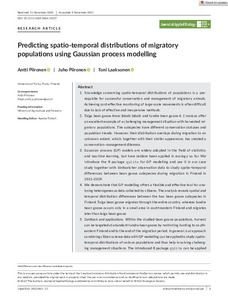Predicting spatio-temporal distributions of migratory populations using Gaussian process modelling
Laaksonen Toni; Piironen Antti; Piironen Juho
https://urn.fi/URN:NBN:fi-fe2022081154486
Tiivistelmä
1. Knowledge concerning spatio-temporal distributions of populations is a prerequisite for successful conservation and management of migratory animals. Achieving cost-effective monitoring of large-scale movements is often difficult due to lack of effective and inexpensive methods.
2. Taiga bean goose Anser fabalis fabalis and tundra bean goose A. f. rossicus offer an excellent example of a challenging management situation with harvested migratory populations. The subspecies have different conservation statuses and population trends. However, their distribution overlaps during migration to an
unknown extent, which, together with their similar appearance, has created a conservation–management dilemma.
3. Gaussian process (GP) models are widely adopted in the field of statistics and machine learning, but have seldom been applied in ecology so far. We introduce the R package gplite f or G P m odelling and use it in our case study together with birdwatcher observation data to study spatio-temporal differences between bean goose subspecies during migration in Finland in 2011–2019.
4. We demonstrate that GP modelling offers a flexible and effective tool for analysing heterogeneous data collected by citizens. The analysis reveals spatial and temporal distribution differences between the two bean goose subspecies in Finland. Taiga bean goose migrates through the entire country, whereas tundra bean goose occurs only in a small area in south-eastern Finland and migrates later than taiga bean goose.
5. Synthesis and applications. Within the studied bean goose populations, harvest can be targeted at abundant tundra bean goose by restricting hunting to south-eastern Finland and to the end of the migration period. In general, our approach combining citizen science data with GP modelling can be applied to study spatio-temporal distributions of various populations and thus help in solving challenging management situations. The introduced R package gplite can be applied not only to ecological modelling, but to a wide range of analyses in other fields of science.
Kokoelmat
- Rinnakkaistallenteet [19207]
